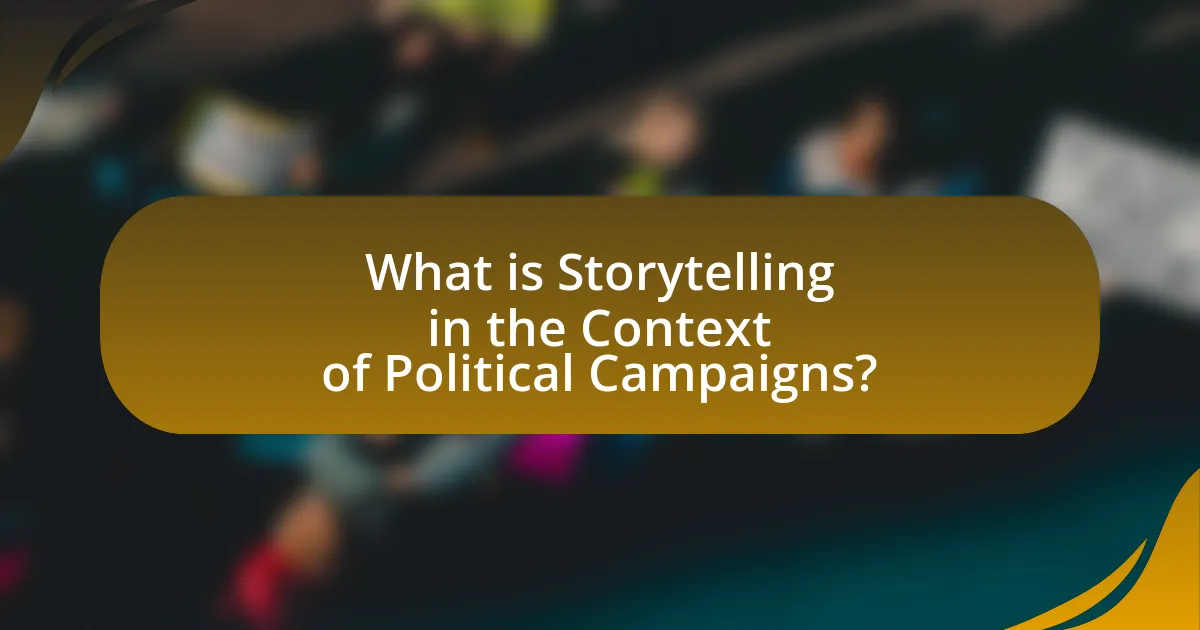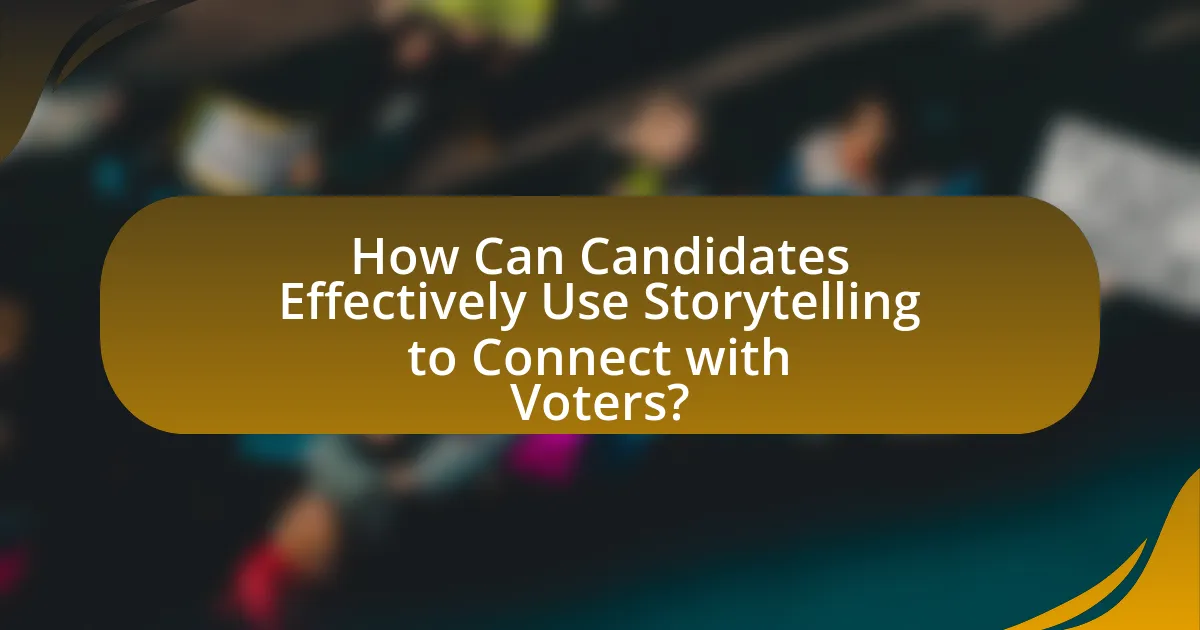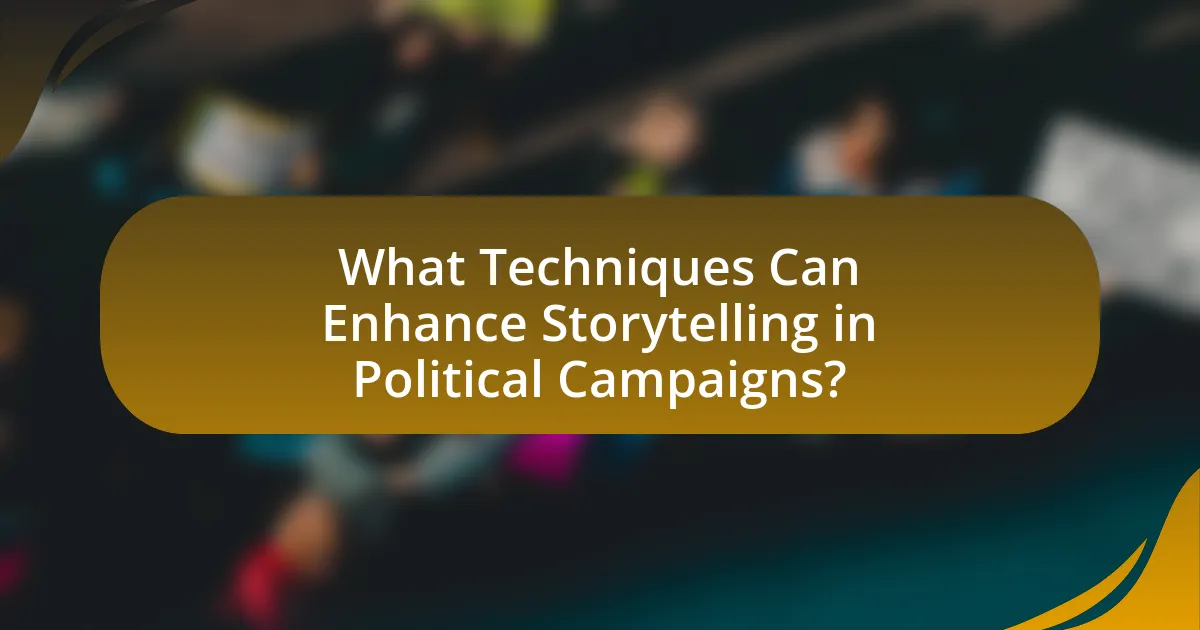The article focuses on the strategic use of storytelling in political campaigns to effectively connect with voters. It outlines how narratives can influence voter perception, enhance emotional engagement, and differentiate candidates in a competitive political landscape. Key elements of effective storytelling, such as authenticity, emotional resonance, and relatability, are discussed, along with techniques for tailoring stories to specific audiences and utilizing multimedia platforms. Additionally, the article highlights best practices for integrating storytelling into campaign strategies and metrics for measuring its effectiveness in engaging voters.

What is Storytelling in the Context of Political Campaigns?
Storytelling in the context of political campaigns is the strategic use of narrative to convey a candidate’s message, values, and vision to voters. This technique engages audiences emotionally, making complex political issues relatable and memorable. For instance, successful campaigns often utilize personal anecdotes or compelling narratives that resonate with voters’ experiences, thereby fostering a deeper connection. Research indicates that narratives can significantly influence voter perceptions and decision-making, as they help to humanize candidates and clarify their positions on key issues.
How does storytelling influence voter perception?
Storytelling significantly influences voter perception by creating emotional connections and enhancing relatability to political messages. When candidates share personal narratives or compelling stories, they can evoke empathy and resonate with voters’ experiences, making their platforms more memorable. Research indicates that narratives can shape attitudes and beliefs; for instance, a study published in the journal “Political Psychology” found that voters are more likely to support candidates whose stories align with their values and experiences. This emotional engagement can lead to increased trust and a stronger sense of identification with the candidate, ultimately affecting voting behavior.
What psychological mechanisms are at play in storytelling?
Psychological mechanisms in storytelling include emotional engagement, cognitive processing, and social connection. Emotional engagement occurs when narratives evoke feelings, leading to increased empathy and identification with characters, which can influence attitudes and behaviors. Cognitive processing involves the brain’s ability to organize and interpret information, making stories easier to remember and relate to compared to abstract data. Social connection is fostered through shared narratives, creating a sense of belonging and community among listeners. Research indicates that stories activate brain regions associated with emotion and memory, enhancing their persuasive power, as demonstrated in studies by Paul Zak, which show that storytelling can increase oxytocin levels, promoting trust and cooperation.
How does storytelling create emotional connections with voters?
Storytelling creates emotional connections with voters by presenting relatable narratives that resonate with their experiences and values. When politicians share personal stories or anecdotes, they humanize themselves, making it easier for voters to identify with them. Research indicates that emotional engagement significantly influences decision-making; for instance, a study published in the journal “Political Psychology” found that emotionally charged narratives can enhance voter motivation and support. By tapping into shared emotions such as hope, fear, or empathy, storytelling fosters a sense of community and belonging among voters, ultimately strengthening their connection to the candidate or cause.
Why is storytelling important for political candidates?
Storytelling is important for political candidates because it helps them connect emotionally with voters, making their messages more relatable and memorable. By sharing personal narratives or anecdotes, candidates can illustrate their values and policy positions in a way that resonates with the electorate. Research indicates that stories activate emotional responses in the brain, which can lead to increased engagement and support; for instance, a study by the University of California found that narratives can enhance persuasion by up to 20%. This emotional connection fosters trust and loyalty, essential elements for building a strong voter base.
What role does storytelling play in differentiating candidates?
Storytelling plays a crucial role in differentiating candidates by allowing them to convey their personal experiences, values, and visions in a relatable manner. This narrative approach helps candidates stand out in a crowded political landscape, as it fosters emotional connections with voters. Research indicates that candidates who effectively use storytelling can increase voter engagement and retention; for instance, a study by the Harvard Kennedy School found that narratives can significantly enhance the persuasiveness of political messages. By sharing compelling stories, candidates can illustrate their authenticity and commitment, making them more memorable and appealing to the electorate.
How can storytelling enhance a candidate’s message?
Storytelling enhances a candidate’s message by making it more relatable and memorable to voters. When candidates share personal anecdotes or narratives, they create emotional connections that resonate with the audience, leading to increased engagement. Research indicates that stories are processed in the brain differently than facts; they activate emotional responses, which can influence decision-making. For instance, a study published in the journal “Psychological Science” found that narratives can significantly impact attitudes and behaviors, demonstrating that storytelling can effectively sway public opinion and foster a sense of trust in the candidate.

How Can Candidates Effectively Use Storytelling to Connect with Voters?
Candidates can effectively use storytelling to connect with voters by sharing personal narratives that resonate emotionally and highlight shared values. This approach allows candidates to humanize themselves, making their policies more relatable and memorable. For instance, a candidate discussing their upbringing in a working-class family can illustrate their commitment to economic issues, thereby fostering a sense of trust and understanding among voters. Research shows that stories can significantly enhance message retention; a study by the Stanford Graduate School of Business found that stories are 22 times more memorable than facts alone. By weaving personal experiences into their campaign messages, candidates can create a compelling narrative that engages voters and encourages them to feel a personal connection to the candidate’s vision and goals.
What are the key elements of effective political storytelling?
The key elements of effective political storytelling include authenticity, emotional resonance, relatability, and a clear narrative structure. Authenticity ensures that the story reflects genuine experiences and values, which builds trust with the audience. Emotional resonance engages voters on a personal level, making them feel connected to the message. Relatability allows voters to see themselves in the story, fostering a sense of shared experience. A clear narrative structure, with a beginning, middle, and end, helps convey the message effectively and keeps the audience engaged. These elements are supported by research indicating that stories with emotional appeal are more persuasive and memorable, as demonstrated in studies by the Stanford Graduate School of Business, which found that emotional storytelling can significantly influence decision-making.
How do personal anecdotes resonate with voters?
Personal anecdotes resonate with voters by creating emotional connections and relatability. When candidates share their personal stories, they humanize themselves, making it easier for voters to see them as relatable individuals rather than distant politicians. Research indicates that narratives can significantly influence voter attitudes; for instance, a study published in the journal “Political Psychology” found that personal stories can enhance the perceived authenticity of candidates, leading to increased trust and support. This emotional engagement is crucial, as voters are more likely to remember and be influenced by stories that evoke feelings, thereby enhancing the candidate’s appeal and connection with the electorate.
What narrative structures are most effective in political storytelling?
The most effective narrative structures in political storytelling include the hero’s journey, problem-solution, and personal anecdotes. The hero’s journey engages voters by framing the politician as a relatable protagonist overcoming challenges, which fosters emotional connection. The problem-solution structure clearly outlines societal issues and presents the politician’s proposed solutions, making the narrative compelling and actionable. Personal anecdotes humanize politicians, allowing voters to see their experiences and values, thus enhancing relatability and trust. Research indicates that narratives utilizing these structures can significantly increase voter engagement and support, as evidenced by successful political campaigns that have employed them effectively.
How can candidates tailor their stories to different audiences?
Candidates can tailor their stories to different audiences by understanding the values, interests, and concerns of each group. This involves conducting audience research to identify key demographics and preferences, allowing candidates to adjust their narratives accordingly. For example, a candidate might emphasize economic growth and job creation when addressing business owners, while focusing on healthcare access and education when speaking to families. This strategic alignment of storytelling with audience priorities enhances relatability and engagement, ultimately fostering a stronger connection with voters.
What factors should be considered when crafting a story for a specific demographic?
When crafting a story for a specific demographic, it is essential to consider cultural relevance, values, and communication preferences. Cultural relevance ensures that the story resonates with the demographic’s experiences and backgrounds, which can enhance relatability and engagement. Values play a crucial role as they shape the beliefs and motivations of the audience; aligning the story with these values can foster a deeper connection. Communication preferences, including language, tone, and medium, must also be tailored to the demographic to ensure effective delivery and comprehension. For instance, research indicates that millennials prefer authentic narratives delivered through social media platforms, while older demographics may favor traditional media.
How can cultural context influence storytelling effectiveness?
Cultural context significantly influences storytelling effectiveness by shaping the values, beliefs, and experiences that resonate with an audience. When stories align with the cultural norms and expectations of a specific group, they become more relatable and impactful. For instance, research by the Pew Research Center indicates that narratives reflecting shared cultural experiences can enhance emotional engagement and foster a sense of community among voters. This alignment allows storytellers to effectively communicate messages that motivate action and build trust, ultimately leading to greater influence in political contexts.

What Techniques Can Enhance Storytelling in Political Campaigns?
Techniques that can enhance storytelling in political campaigns include the use of personal narratives, emotional appeals, and relatable characters. Personal narratives allow candidates to share their own experiences, making them more relatable and authentic to voters. Emotional appeals engage voters on a deeper level, fostering empathy and connection; for instance, stories that highlight struggles or triumphs can resonate strongly with audiences. Relatable characters, whether they are constituents or fictional representations, help to illustrate the impact of policies and create a narrative that voters can see themselves in. Research shows that campaigns utilizing these techniques can increase voter engagement and support, as evidenced by the success of Barack Obama’s 2008 campaign, which effectively employed personal storytelling to connect with diverse voter demographics.
How can visual storytelling complement verbal narratives?
Visual storytelling can enhance verbal narratives by providing a multi-sensory experience that engages audiences more deeply. This combination allows for complex ideas to be conveyed more effectively, as visuals can simplify and clarify verbal messages, making them more memorable. Research indicates that people retain information better when it is presented both visually and verbally, with studies showing that visuals can increase retention rates by up to 65%. By integrating images, videos, or infographics with spoken or written narratives, communicators can evoke emotions and create a stronger connection with their audience, which is particularly beneficial in political contexts where emotional engagement is crucial for voter connection.
What types of visuals are most impactful in political storytelling?
Emotional imagery is the most impactful type of visual in political storytelling. This type of visual evokes strong feelings and can create a personal connection between the audience and the political message. For instance, images depicting real people affected by policies, such as families facing economic hardship or individuals benefiting from healthcare reforms, can significantly influence voter perceptions and decisions. Research indicates that emotionally charged visuals can increase engagement and retention of information, making them a powerful tool in political campaigns.
How can multimedia platforms enhance storytelling reach?
Multimedia platforms enhance storytelling reach by allowing creators to combine various forms of content, such as text, audio, video, and interactive elements, to engage audiences more effectively. This integration caters to diverse learning styles and preferences, increasing the likelihood of audience retention and emotional connection. For instance, a study by the Pew Research Center found that 64% of Americans believe that video content is more engaging than text alone, demonstrating the power of visual storytelling in capturing attention. Additionally, platforms like social media enable rapid sharing and wider dissemination of stories, amplifying their impact and reach across different demographics.
What are common pitfalls to avoid in political storytelling?
Common pitfalls to avoid in political storytelling include oversimplification, lack of authenticity, and failure to connect emotionally with the audience. Oversimplification can lead to a narrative that does not accurately represent complex issues, which can alienate informed voters. Lack of authenticity undermines credibility; voters are more likely to engage with genuine stories that reflect real experiences. Additionally, failing to connect emotionally can result in a disengaged audience; research shows that emotional narratives are more effective in influencing voter behavior. For instance, a study by the University of Southern California found that emotionally charged stories significantly increased voter turnout compared to fact-based messaging.
How can candidates ensure authenticity in their stories?
Candidates can ensure authenticity in their stories by sharing personal experiences that genuinely reflect their values and beliefs. This approach fosters a deeper connection with voters, as authenticity resonates more than rehearsed narratives. Research indicates that voters are more likely to trust candidates who present relatable and honest accounts of their lives, as seen in studies conducted by the Pew Research Center, which highlight the importance of personal storytelling in political communication. By being transparent and vulnerable, candidates can create a narrative that not only engages but also builds trust with their audience.
What strategies can prevent storytelling from becoming manipulative?
To prevent storytelling from becoming manipulative, storytellers should prioritize authenticity, transparency, and audience engagement. Authenticity ensures that the narrative reflects genuine experiences and emotions, which fosters trust. Transparency involves openly sharing the intent behind the story, allowing the audience to understand the purpose without feeling deceived. Engaging the audience through interactive elements or feedback mechanisms can also help maintain a two-way communication channel, making the storytelling process more collaborative and less coercive. Research indicates that narratives grounded in real-life experiences resonate more effectively with audiences, as seen in studies by Green and Brock (2000), which highlight the importance of relatable content in fostering genuine connections.
What are some best practices for integrating storytelling into campaign strategies?
Best practices for integrating storytelling into campaign strategies include identifying a clear narrative that resonates with the target audience, using relatable characters to humanize the message, and employing emotional triggers to foster connection. Research shows that narratives can increase engagement by up to 65%, as they help voters relate personally to the campaign’s themes. Additionally, utilizing various media formats—such as videos, social media posts, and live events—can enhance the storytelling experience and reach a broader audience. Consistency in messaging across all platforms reinforces the story and strengthens voter recall, making it a crucial element in effective campaign strategies.
How can storytelling be used across different campaign platforms?
Storytelling can be effectively used across different campaign platforms by creating a cohesive narrative that resonates with the target audience. Campaigns can utilize various formats such as videos, social media posts, podcasts, and blogs to share personal stories, testimonials, and relatable experiences that highlight key messages. For instance, a study by the Stanford Graduate School of Business found that stories are 22 times more memorable than facts alone, demonstrating the power of narrative in engaging voters. By tailoring the storytelling approach to each platform’s unique characteristics, campaigns can enhance emotional connections and drive voter engagement.
What metrics can be used to measure the effectiveness of storytelling in campaigns?
Metrics that can be used to measure the effectiveness of storytelling in campaigns include engagement rates, conversion rates, brand recall, and sentiment analysis. Engagement rates, such as likes, shares, and comments on social media, indicate how well the story resonates with the audience. Conversion rates measure the percentage of individuals who take a desired action after interacting with the story, reflecting its persuasive power. Brand recall assesses how well the audience remembers the campaign’s message and associated brand, which is crucial for long-term impact. Sentiment analysis evaluates the emotional response to the story, providing insights into audience perceptions and attitudes. These metrics collectively offer a comprehensive view of storytelling effectiveness in connecting with voters.
